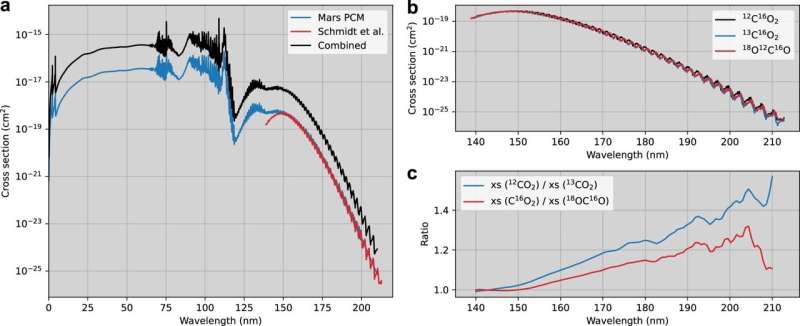This article has been reviewed according to Science X's editorial process and policies. Editors have highlighted the following attributes while ensuring the content's credibility:
fact-checked
peer-reviewed publication
trusted source
proofread
Space scientists provide new insight into the evolution of Mars' atmosphere

Scientists at The Open University (OU) have analyzed isotopic measurements in the atmosphere of Mars, providing new information on the evolution of the Martian climate throughout history and the origin of surface organics on Mars.
The atmosphere of Mars, which is mostly made of carbon dioxide (CO2), is relatively enriched in "heavy" carbon (13C) with respect to Earth due to the preferential escape of "light" carbon (12C) to space over several billion years.
Scientists from the OU's Atmospheric Research and Surface Exploration group have analyzed data from the ExoMars Trace Gas Orbiter (TGO) mission, which indicate that Martian carbon monoxide (CO) is depleted in heavy carbon instead.
Dr. Juan Alday, lead author of the study which is published in Nature Astronomy, explains, "The key for understanding why there is less 13C in CO lies in the chemical relationship between CO2 and CO. When CO2 molecules are destroyed by sunlight to form CO, 12CO2 molecules are more efficiently destroyed than 13CO2, leading a depletion of 13C in CO over long periods of time."
Despite the small amount of CO in the atmosphere of Mars (less than 0.1%), these new measurements have important implications to our understanding of the evolution of the Martian climate and can help determine the historical climate conditions that enabled the presence of liquid water on the surface of early Mars.
Dr. Alday commented, "We do not know what the atmosphere of early Mars was like nor what conditions allowed liquid water to flow on the surface. The isotopes of carbon on Mars' atmosphere can help us estimate how much CO2 there was in the past.
"The new measurements by the ExoMars TGO suggest that less CO2 has escaped the planet than previously thought and provide new constraints on the composition of this early atmosphere of Mars."
Recent measurements made by NASA's Curiosity Rover on the surface revealed a depletion of 13C in surface organic material.
Manish Patel, who leads the OU ExoMars research group, said, "There is a long-standing debate on whether organic material on the surface of Mars was produced by biological or non-biological processes.
"The fact that both atmospheric CO and surface organics share this 13C-depleted isotopic signature that Juan has measured may indicate these organics are more likely to be non-biological in origin, although other origins cannot be ruled out based solely on this information."
More information: Juan Alday et al, Photochemical depletion of heavy CO isotopes in the Martian atmosphere, Nature Astronomy (2023). DOI: 10.1038/s41550-023-01974-2
Journal information: Nature Astronomy
Provided by The Open University




















